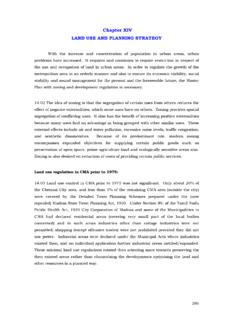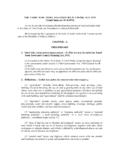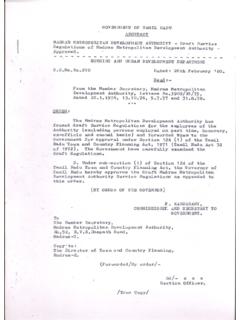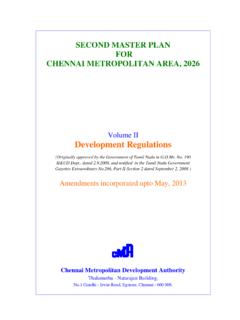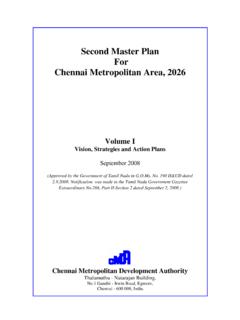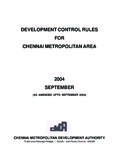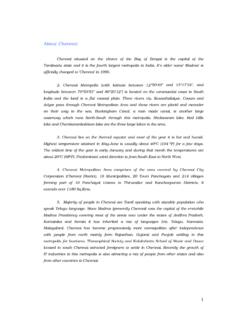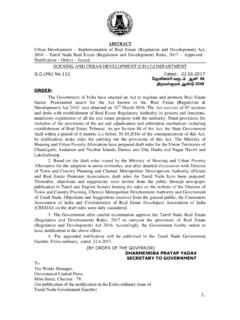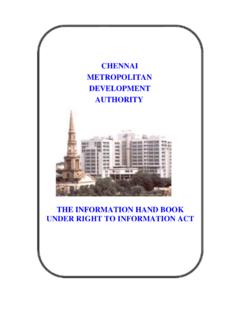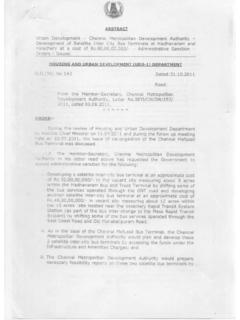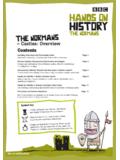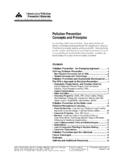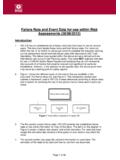Transcription of MACRO DRAINAGE SYSTEM IN CMA - Chennai …
1 Chapter IX MACRO DRAINAGE SYSTEM in CMA A. Current Situation Chennai City and environs are very flat with contours ranging from 2m to 10 m above MSL with a few isolated hillocks in the southwest at St. Thomas Mount, Pallavaram and Tambaram. It is traversed by three major rivers namely Kosasthalaiyar River, Cooum River and Adyar River. The climate of the region is dominated by the monsoons, which are caused by thermal contrast between land and sea. Monsoon climates are characterized by clearly marked seasons with specific types of wind and weather. The South West monsoon dominates weather patterns in Tamil Nadu from July-September and is characterized by periods of sultry wet weather. Rain shadow effects limit rainfall in the East Coast in Tamil Nadu and it is light or intermittent during this season. This period is followed by North-East Monsoon, which brings cool cloudy weather, relatively free of rain over most of the monsoon-dominated land (India).
2 The exception is South-East-India including Tamil Nadu where about 50% of the annual rainfall occurs at this time. The start of the heavy rains usually falls in October lasting up to December. Most of the rainfall is associated with clear synoptic systems of depressions and cyclones with night time rainfall most common. In CMA most of the rainfall occurs between October and December. River Nagari which has a large catchment area in the Chittoor District (Andhra Pradesh) region and the Nandi River, which has catchment area in the Vellore District, join and enter Poondi Reservoir. Kosasthalaiyar River, which has its origin near Kaveripakkam, has a branch near Kesavaram Anicut and flows to the City as Cooum River and the main Kosasthalaiyar river flows to Poondi reservoir. From Poondi reservoir, Kosasthalaiyar River flows through the Tiruvallur District, enters CMA, and joins the Sea at Ennore.
3 Cooum River from the Kesavaram Anicut flows through the Kancheepuram District enters CMA and finally reaches Sea near Fort St. George. Adyar River having its catchment area in the Kancheepuram District and originating from the Pillaipakkam Tank Group and Kavanur Tank Group flows through the CMA enters the City and reaches Sea near Adyar. Sholavaram Tank, Red Hills Tank and Chembarambakkam Tank are the major water bodies in the CMA. Sholavaram Tank is the secondary storage tank receiving water from the Poondi Reservoir via Poondi Feeder Canal to supply Red Hills Tank. Red Hills Tank is the main source of water supply to the Chennai City and during storm events water is released to Red Hills 94 Surplus Channel, which enters the Kosasthalaiyar River and discharges into the Sea. Its maximum storage capacity is 3285 Mft3 ( Mm3).
4 Chembarambakkam Tank has recently been developed as one of the sources for water supply to Chennai City and has maximum storage capacity of 103 Million m3. In spite of the fact that the region has such large lengths of DRAINAGE (158 km) and extensive water storage systems of tanks and reservoirs the region especially the City suffers from regular annual flooding of developed and settled areas. The last century records have shown that there were several catastrophic flooding in Chennai in 1943, 1978, 1985, 2002 and 2005 caused by heavy rain associated with cyclonic activity. These events of catastrophic flooding were found to be attributable to failure of the major rivers and other DRAINAGE systems. Flooding of less catastrophic nature occurs regularly in low-lying areas of the City and its suburbs because of inadequacy or inoperativeness of the local DRAINAGE infrastructure.
5 The floods in 1943 were historic and damaged Cooum river very badly. Based on the Er. A. R. Venkatachary s Report the Government had improved the Cooum river and provided a sand pump at the river mouth for removal of sand bar. In 1976, there was catastrophic flooding in Chennai and this time it was the turn of the Adyar river. Er. P. Sivalingam Committee had given its recommendations for prevention for further damages from floods and recommended schemes to be implemented in the short and long terms. The floods that occurred in 2005 were the worst in living memory. Although several ameliorating measures have been implemented they have failed to provide total relief to Chennai citizens. The reasons for this state of affairs are three-fold. Most of the existing waterways are silted and their flow channels and banks are obstructed with encroachments and structures.
6 Similar is the case with the reservoirs and tanks. Secondly several of the areas under tanks and their anicuts have been developed as residential neighbourhoods over the years. T. Nagar, Nungambakkam, Vyasarpadi are instances in this respect. The Taramani area has been developed as an institutional area. Thirdly the geological structure particularly in the south-west is not conducive to water infiltration. 95 The annual flooding of low-lying areas has besides causing loss of property, is disrupting the life of many slum dwellers through displacement and heavy expenditure on their relief, loss of manpower in industry and business and damage to infrastructure. More importantly it impinges on the health of the citizens through epidemics like dysentery, typhoid and cholera. Malarial as well as other types of mosquitoes have returned to Chennai in full force.
7 Several studies have been made to analyse the situation and find solutions to mitigate the problems of flooding and cleaning up of the environmentally degraded waterways particularly the Cooum, Buckingham Canal and Adyar. A map showing water bodies and flood plains is annexed. The more important studies made so far are listed below: i) Er. P. Sivalingam Committee report, 1976 ii) PWD Nucleus Cell Report, 1980 iii) Madras Metro Flood Relief / Storm Water DRAINAGE Master Plan Study, 1993 iv) Storm Water DRAINAGE Master Plan for Madras City and Pre-feasibility Study for CMA,1994 v) EIA of the DRAINAGE and Redevelopment Proposal For the Pallikkaranai Area, 1995 vi) Review of EIA by NEERI, 1998 DRAINAGE study for Pallikkaranai The DRAINAGE study for Pallikkaranai was included as part of the MMFR/SWD master plan study. The aim of the study is to identify ways of providing protection to an area about 30 lying in and around Pallikkaranai.
8 The area was earmarked for development and the development was to be promoted by a number of government and private bodies then. For the purpose of the study the area was referred as Pallikkaranai DRAINAGE Area (PDA). The aim of the project was to protect an area of approximately 30 from flooding. It could be achieved by a diversion of substantial portion of run-off from upstream catchments along a cut-off drain linking the existing surplus channel close to a village called Karanai with the Kovalam Backwaters. Northern boundaries of Pallikkaranai DRAINAGE Area cuts off the centre of the existing swamp area at Pallikkaranai. The area to the north will continue to be subject to inundation as run-off enters the area from north and west. Protection to the area is to be provided by three interceptor drains, which carry overland flows from local catchment around the boundary of the PDA.
9 An arterial drain has to be constructed along the centre of the PDA, which will pick up DRAINAGE flows within the area. 96 Stakeholders The principal stakeholders for managing the MACRO DRAINAGE SYSTEM is the PWD with some transferred responsibility to Chennai Corporation and Metrowater. Revenue department is also an important stakeholder as it is in charge of the lands covered by waterways and reservoirs. The micro DRAINAGE storm water DRAINAGE SYSTEM is the responsibility of the Municipal Corporation, Municipalities and other Local Bodies. C. Policies and Strategies i) The most important policy would be to convert the present constraints in disposal of flood waters as an opportunity to manage and use the excess water for augmenting urban water supply through creation of additional storage capacity.
10 Ii) Developing a network of open spaces to provide green environment would enable them to be used as flood moderators during critical months of the year. iii) The PWD needs to be made the nodal agency for holistic planning and maintenance of existing water bodies by preventing encroachments and implementation of MACRO DRAINAGE systems. iv) Micro DRAINAGE would be the responsibility of the local bodies and they would need to be fully and effectively integrated with the MACRO SYSTEM . D. The Plan i) The CMDA s land use plan identifies all the important MACRO DRAINAGE features and prescribes the extent to which the conservation area extends. The lakes and water bodies need to be protected from encroachments and existing encroachments should be removed bringing the water bodies to their original state. ii) The land use plan identifies the critical areas subject to annual flooding for taking up remediation measures by local bodies in collaboration with the PWD.
